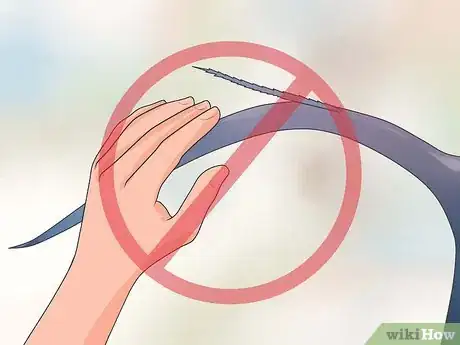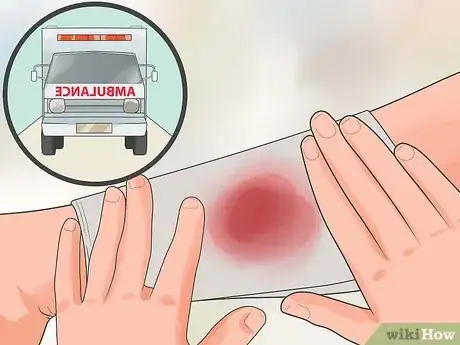wikiHow is a “wiki,” similar to Wikipedia, which means that many of our articles are co-written by multiple authors. To create this article, 21 people, some anonymous, worked to edit and improve it over time.
This article has been viewed 67,920 times.
Learn more...
If you’re heading to a tropical destination close to the Caribbean Sea, chances are you might get a chance to swim with stingrays on a guided tour. Tourists drop millions of dollars each year to experience swimming with these gentle giants[1] , but following the death of Australian naturalist Steve Irwin due to a stingray barb, many tourists are wondering how to swim with stingrays safely.[2] It’s important that you book a tour that is trusted and well monitored. As well, you should be aware of the possible risks of swimming with stingrays and take precautions to avoid getting injured while you enjoy this unique experience.
Steps
Booking a Stingray Swim Tour
-
1Keep in mind the rarity of serious stingray injuries. There have been only 17 stingray deaths recorded worldwide and it is rare to have a vital organ punctured by a stingray barb. The death of Steve Irwin, for example, is considered a tragedy in the naturist community partly because dying from a stingray barb is so uncommon. By nature, stingrays are docile, nocturnal creatures who do not attack humans. But they are easily frightened and disturbed if they are stepped on or startled by someone walking into the water, close to them.[3] [4]
- You can receive a minor injury from a stingray barb on your leg or toe if you accidentally step on a stingray’s tail or tread on a stingray that feels threatening to a stingray. Upon stepping on the stingray, the ray will respond by flipping its tail, which has a barb at the end, towards you. The barb may then come into contact with your foot, ankle, or toe.[5] Depending on the severity of the barb injury, you may have excessive bleeding and require medical care or stitches once the venomous barb is removed.[6]
-
2Look for guided tours in a small group. When you book a swim with the stingrays excursion, look for a guided tour that allows no more than 10 people. This will ensure the tour guide can see everyone in the water and keep everyone safe while you swim with the stingrays.[7]
- Many of these tours can be found in destinations on the coast of the Caribbean Sea, such as the Bahamas or the Cayman Islands. The tour guide will take you to an area known to have a high stingray population and allow you to wade around in waist deep water. These stingrays will likely act like captive animals, as they have become accustomed to human interaction. You may be given a snorkeling masks to look at the stingrays under the water and you will be allowed to touch the front area of the stingrays.[8]
- You will also be given food that you can throw into the water to feed and attract the stingrays. Be cautious about over feeding the stingrays, as they can swarm around you and you may lose your footing. This could result in stepping on the tail of a stingray and getting a barb injury in your foot.[9]
Advertisement -
3Ask about safety controls before you book the tour. A good tour guide will go over safety controls and precautions when you call to book the tour. Ask the guide about the precautions around avoiding stingray barbs and injuries due to the barbs. Most guides will instruct you to never touch the stingrays’ tails while in the water with them and to make calm, slow movements so you do not startle or scare the stingrays.
-
4Check reviews of the tour on an online review site. Many tours are reviewed online on TripAdvisor.com, with detailed reviews discussing safety precautions on the tour, the quality of the tour guide, and the overall experience. Search the name of the tour online before you book it to read reviews and ensure there are no overwhelmingly negative reviews for the tour.
Taking Precautions in the Water
-
1Do the stingray shuffle once you get in the water. Stingrays will often bury themselves in the sand in shallow water to protect themselves from predators. They may even change color to blend into the sand and disguise themselves. This makes it hard for predators to spot them, and for you to spot them as you walk into the shallow water. Avoid making contact with a stingray barb by shuffling your feet from side to side as you walk into the water. This will ensure you never step on a stingray and decrease your chances of getting stung.[10]
- Though it may be hard to see stingrays in the shallow water if they are hiding in the sand, you should always watch where you step when entering the ocean. Look for wide, gray discs floating over the sand and try to step around them, rather than on them.
- In the Caribbean, southern stingrays can grow to as wide as 6.5 feet[11] , and in the Atlantic Ocean, Atlantic stingrays can grow to be as wide as 20 inches.[12]
-
2Avoid touching or irritating the stingray’s tail. Stingrays have long, whip like tails that contain one or more serrated, razor like barbs. They use their tails for defense against predators, like sharks, and will only flick their tails if they feel threatened or are disturbed in an aggressive way. When you are swimming with the stingrays, you should only touch the front area, or disc area of the rays. Do not place your hand too close to the stingray’s tail or on the stingray’s tail.[13]
- You should also never swim directly over a stingray, as this could be seen as threatening, and when you are diving or snorkeling in an uncontrolled environment with wild stingrays, avoid going too close to them.[14]
-
3Remove the barb if you can see it on the surface of your skin. If you get stung by a stingray during your tour and you can see the barb in the wound and it appears to be easy to remove, use sanitized tweezers to take it out. This will stop the transfer of the venom from the barb into your body.
- Avoid agitating the barb if it remains deep in the wound once you are stung. Removing it from a deep wound can result in blood lose and other medical issues. Instead, let a medical professional remove it in the hospital.
-
4Head to the nearest medical clinic. The sting of a stingray is very painful and requires immediate medical attention to reduce the pain and clean the wound so it does not get infected. If you lose consciousness after you are stung, someone should call 911 right away as you may be in shock or have a drastic drop in your blood pressure. As well, if the barb breaks off in the wound and is embedded in the wound, it will need to be removed by a doctor at a hospital to prevent infection.[15]
- Any stings to areas besides your legs and arms, such as your chest or abdomen, are considered serious, life threatening stings and should be treated at a hospital.
- If you are stung while on a swim with the stingrays tour, inform the tour guide, who should stop the tour and take you to the nearest hospital or clinic. You should soak the affected area with hot water to help reduce the venom in the wound and allow the doctor at the hospital or clinic to treat the wound.[16]
- If you are stung while in the ocean and there is a lifeguard on duty, signal to the lifeguard, who will help you out of the water and apply the necessary treatment. You should go to the hospital if the sting is severe or if the barb breaks off in the wound.
References
- ↑ http://www.takepart.com/article/2013/04/18/why-you-should-not-swim-with-stingrays
- ↑ http://www.nbcnews.com/id/14800994/ns/travel-cruise_travel/t/are-stingray-tours-safe/#.VeiVPGTBzGc
- ↑ http://www.nbcnews.com/id/14800994/ns/travel-cruise_travel/t/are-stingray-tours-safe/#.VeiVPGTBzGc
- ↑ http://www.ci.solana-beach.ca.us/index.asp?SEC=7FCF7878-6E7E-4424-BE7F-47EFEAA7DA80
- ↑ http://www.beachhunter.net/download/floridabeachsafety_v2.pdf
- ↑ http://www.nbcnews.com/id/14800994/ns/travel-cruise_travel/t/are-stingray-tours-safe/#.VeiVPGTBzGc
- ↑ http://www.takepart.com/article/2013/04/18/why-you-should-not-swim-with-stingrays
- ↑ http://www.nbcnews.com/id/14800994/ns/travel-cruise_travel/t/are-stingray-tours-safe/#.VeiVPGTBzGc
- ↑ http://www.nbcnews.com/id/14800994/ns/travel-cruise_travel/t/are-stingray-tours-safe/#.VeiVPGTBzGc
- ↑ http://www.beachhunter.net/download/floridabeachsafety_v2.pdf
- ↑ http://www.nbcnews.com/id/14800994/ns/travel-cruise_travel/t/are-stingray-tours-safe/#.VeiVPGTBzGc
- ↑ http://www.beachhunter.net/download/floridabeachsafety_v2.pdf
- ↑ http://www.beachhunter.net/download/floridabeachsafety_v2.pdf
- ↑ http://www.nbcnews.com/id/14800994/ns/travel-cruise_travel/t/are-stingray-tours-safe/#.VeiVPGTBzGc
- ↑ http://www.beachhunter.net/download/floridabeachsafety_v2.pdf
- ↑ http://www.ci.solana-beach.ca.us/index.asp?SEC=7FCF7878-6E7E-4424-BE7F-47EFEAA7DA80



































































